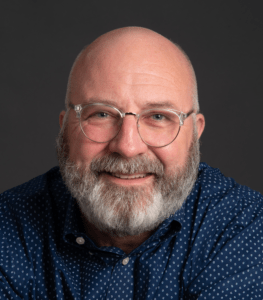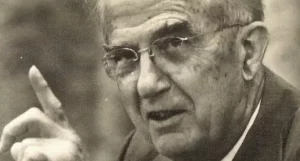One of the things that’s easy to forget about the conviction of three white men for the cold-blooded murder of Ahmaud Arbery is that there almost wasn’t a trial. There were no arrests for two months after the murder. Two district attorneys passed on the case, as if to say, “Nothing to see here. Move along.”
It appears that the presumption of this being a justified way of life in this coastal Georgia town ran so strong that those in a position to pursue justice merely accepted it and moved on.
This ingrained view of the world is so strong that it was Greg McMichael — one of the three now imprisoned — who made public the video of the murder that was shot on a cellphone by another of the perpetrators, William Bryan. Here’s the important point: McMichael made the video public because he thought it would exonerate him and his accomplices.

Mark Wingfield
“There had been very little information provided by the police department or the district attorney’s office, but there was entirely too much speculation, rumor, false narratives, and outright lies surrounding this event,” attorney Alan Tucker told Georgia Public Broadcasting at the time. Tucker helped McMichael get the video out.
Tucker and McMichael thought releasing the video would exonerate the three men in the court of public opinion. The same video that became a central, damning piece of evidence in the case against the three men. That’s what he thought would prove his justification.
Thankfully, a majority of Americans who saw the video were outraged and saw it as evidence of the lynching it was. Thankfully, an almost all-white jury watched the video and saw it as evidence of the lynching it was.
How is it that two kinds of people can watch the same video and come to polar-opposite conclusions about what they have seen? This is the same phenomenon that happened on Jan. 6 when — depending on your perspective — either insurrectionists or patriots stormed the U.S. Capitol. We all watched the same video footage of that event, and yet almost all the Republican members of Congress who were threatened by the attack now want us to believe there was “nothing to see here.” Or worse, there are those who continue to twist the obvious to say those weren’t Trump-supporting insurrectionists but were instead “antifa.”
“How is it that two kinds of people can watch the same video and come to polar-opposite conclusions about what they have seen?”
This is the same kind of frustrating logic that has led to divergent interpretations of other events captured on video: 17-year-old Kyle Rittenhouse patrolling the streets of Kenosha, Wis., with a semiautomatic weapon; a white police officer holding down George Floyd on a Minneapolis street while the Black man pleaded, “I can’t breathe”; and any number of other marches, police stops or rallies.
The Washington Post quoted University of Maryland sociology professor Rashawn Ray explaining how this worked in the Georgia case: “Video is an objective observer. It’s very clear what happened. And I think part of what the McMichaels were trying to leverage was what their defense attorneys were trying to allege: that the mere presence, the mere physical body of Ahmaud Arbery as a Black person just running through the street should pose a big enough threat to justify their use of force.”

Ahmaud Arbery stumbling while being chased by three white men. Captured on cellphone video.
That’s it. Take that last sentence — “the mere presence, the mere physical body of ____ as a _____ person just running through the street should pose a big enough threat to justify their use of force” — and substitute other words into the blanks: Immigrant. Refugee. Asian. Gay. African. What you can’t successfully substitute here are words like “wealthy” or “white.”
Donald Trump was elected president by making statements exactly like this, and his base ate it up like pumpkin pie on Thanksgiving.
What’s dividing America today is not just two views of the same set of facts but the fantasy that “alternative facts” are actually facts. And that is rooted in life experience and worldview. These are not two equally valid points of view.
Herein lies one of the greatest problems with a reflexive “conservative” viewpoint. The driving force of conservatism is to “conserve” traditions or culture. That’s not a bad idea on its own — assuming those traditions or cultures got it right to begin with. It’s one thing to conserve a beloved family recipe for chocolate cake but another to conserve a beloved family tradition of white supremacy.
“There are some ideas and views we do not need to preserve, that we need to abandon and move on from, that we need to show ‘progress’ away from.”
There are some ideas and views we do not need to preserve, that we need to abandon and move on from, that we need to show “progress” away from.
And yes, “progressive” viewpoints can sometimes go too far or be expressed ineloquently. The greatest recent example of that is the “Defund the Police” movement. While heartfelt and driven by appropriate anger, this is neither practical nor reasonable. If carried out by force, it could be equivalent to storming the Capitol.
Except the “Defund the Police” crowd hasn’t actually stormed any police stations and hasn’t denied anyone else’s civil rights. The “Defund the Police” crowd doesn’t roam city streets carrying semiautomatic weapons or try to carry out a “citizen’s arrest” on people who look suspicious to them.
It is inconceivable that there ever was a question about what had happened to Ahmaud Arbery, that some number of Georgia citizens (and others elsewhere) could have believed his murder was justified. This is the very definition of systemic racism — that belief the anti-Critical Race Theory activists don’t want our children taught. Just as it is inconceivable that former President Trump and several Congressional Republicans are fawning all over 18-year-old Kyle Rittenhouse for murdering two people during a protest in Kenosha, Wis., as though he’s a hero for carrying an illegal semiautomatic weapon as a self-appointed security detail.
If any Black man did what Rittenhouse did, he would have been shot on the spot and there never would have been a trial. Just as if three Black men had chased down a white runner in Georgia and executed him, the arrests would have been immediate and there would have been no doubt about the outcome of that trial.
“The problem in America today is not that we have two different political parties; it is, instead, that we have two understandings of truth.”
The problem in America today is not that we have two different political parties; it is, instead, that we have two understandings of truth, two understandings of justice, two understandings of morality, two understandings of the Christian faith, two understandings of what needs to be conserved and where progress needs to be made.
This problem would not be a problem if those in the middle and those on the reasonable side of conservatism would stand up and speak out. Those wanting to conserve America’s racist past and other exclusionary practices are a minority of the population. But they get their way — always — when others vote with them out of fear or keep their mouths shut out of fear.
It’s past time to break that chain of fear and stop conserving things that don’t need to be conserved.
One of the greatest influences on my own thought development in Christian ethics was T.B. Maston, the legendary professor at Southwestern Baptist Theological Seminary who paid a steep price for his stance on racial inclusion in the 1960s and beyond. Although he had retired before I got to Southwestern, he befriended me and I had the pleasure of visiting him and his family in their home adjacent to the campus several times.

T.B. Maston
In a 1981 column for the Baptist Standard, the great ethicist wrote this: “Most of us are mixtures: conservative on some issues, liberal on others. A conservative is one who seeks to conserve or hold onto the past or at least to the present way of life and thought. In contrast, a liberal is one who approves or at least is willing to consider new or different ways. Also, many of us are unquestionably conservative in our theological position and yet we advocate changes or a new perspective concerning certain social customs and issues.
“One of the most prevailing fallacies, particularly among ultra-conservatives, is to label one a ‘liberal’ simply because that one is liberal from their perspective regarding one or more social, economic or political issues. Really, labeling is a method frequently used in an attempt to get rid of an opponent whom we cannot or do not want to answer.
“Some of us believe that in our contemporary world, if we walked in the way that Jesus walked and the way he would have us to walk, we will have to be conservative in our theology but quite liberal from the viewpoint of many as we face the complex issues and problems of our world.”
He often said this even more succinctly: “Be conservative in your theology but liberal in your application of it.”
That third category of Americans Maston described — neither thoroughly conservative nor liberal — is the silent majority today. It’s time to speak up.
Mark Wingfield serves as executive director and publisher of Baptist News Global.
Related articles:
Dear white people like me, this is what it means to accuse Black people of causing the very crimes committed against them | Opinion by Mark Wingfield
Ahmaud, Breonna, Christian, George, and The Talk every black boy receives | Opinion by Timothy Peoples
The power of ‘and’ | Opinion by Doyle Sager


